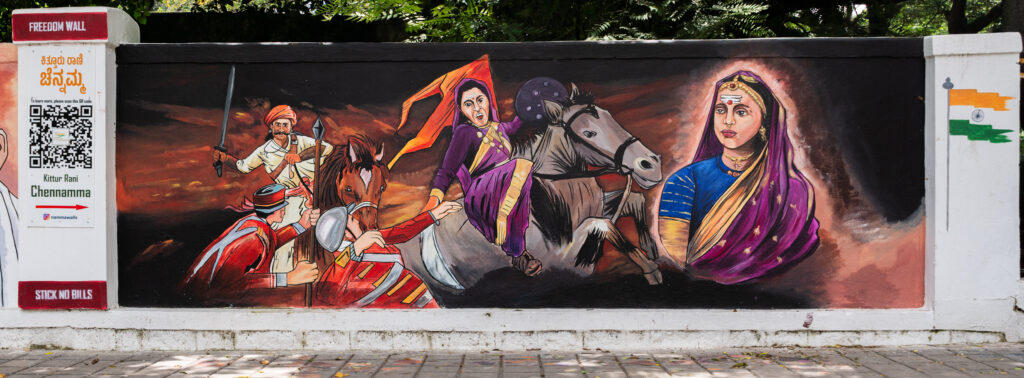Women in Indian History Through Murals

When discussing women’s contributions to Indian history, Kittur Rani Chennamma stands out as an inspiring figure who courageously challenged British colonial power decades before the First War of Independence in 1857
Early Life and Accession
Born on 23 October 1778 in Kakati, in the Belagavi District of present-day Karnataka, Chennamma defied the expectations of her time by learning horse riding, sword fighting, and archery from a young age 16. At the age of 15, she married Raja Mallasarja, the ruler of Kittur, and became the queen upon his death in 1816
Revolt Against the British
The East India Company refused to recognize her adopted son as the legitimate successor, aiming to annex Kittur—long before Lord Dalhousie formally codified the Doctrine of Lapse
Rani Chennamma vehemently rejected the British demand to cede her state and chose to defend her sovereignty. In October 1824, her troops met the British in battle
During the initial confrontation, she claimed victory and even took two British officers hostage, releasing them on the condition that the conflict would end. However, the Company regrouped with larger forces, and despite her leadership and skilled use of guerrilla warfare tactics, Kittur’s defiance was ultimately subdued. Rani Chennamma was captured and imprisoned in the Bailhongal Fort, where she died on 21 February 1829
Lasting Legacy
Rani Chennamma’s bravery made her one of the earliest Indian rulers to wage armed resistance against the British. Even though her struggle ended in captivity, her story continues to be celebrated:
- Kittur Utsav: Held annually in Kittur, commemorating her early success against the British and honoring her steadfast courage16
.
- Public Statues: Statues of Rani Chennamma stand in locations like the Indian Parliament Complex and prominent circles in Karnataka, reminding the nation of her valiant spirit16
.
- Folk Traditions: Ballads and songs celebrating her life are still performed, embedding her heroism in local culture and inspiring new generations1
.
Reflections for a Mural
A mural depicting Kittur Rani Chennamma could capture:
- Her regal armor and sword, symbolizing her readiness to protect her kingdom.
- A backdrop of Kittur Fort, reflecting her strategic and valiant leadership in battle.
- Vibrant motifs featuring traditional Kannada art forms or local flora to root her image in the cultural environment of Karnataka.
Beyond its aesthetic appeal, such a mural can serve as an educational piece—telling the powerful story of a warrior-queen who confronted a formidable empire, showcasing the role of Indian women in shaping the subcontinent’s history, and inspiring conversations on women’s empowerment and resistance to injustice. Discussion Points for Your Blog/Portfolio
- Feminist Lens: Explore how Rani Chennamma’s story defied the gender norms of her time, setting a precedent for women’s leadership6
.
- Cultural Resonance: Reflect on how festivals and historical commemorations (like Kittur Utsav) keep her memory alive1
.
- Artistic Interpretations: Share ideas on mural color palettes, composition styles, or symbolic elements that best highlight her courage and legacy.
Including Kittur Rani Chennamma in your mural series underlines the rich tapestry of Indian history woven by women warriors, reinforcing that the spirit of resistance and the pursuit of freedom had powerful female champions at the forefront.

Leave a Reply